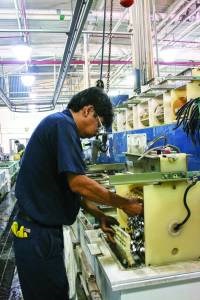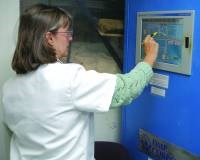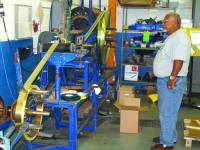Electronics Evolution
Plater adjusts operations to meet changing customer demands
Precision Plating Company (Chicago) knows more about change than many companies.
Launched in 1904 as a decorative plater for production of picture frames and other religious artifact items sold by Chicago’s Marshall Field & Co. department store, the company continued mainly decorative work for the first few decades of its existence.
That began to change in the 1930s when the military approved Precision as a supplier. Then, in the 1970s, the owners hired Jim Belmonti to set up the company’s new plant. Belmonti intensified the company’s focus on the burgeoning electronics plating business, which remains Precision’s main application area today.
Through the 1970s and ‘80s, Precision grew by staying abreast of electronics industry trends and developing and using some proprietary processes in-house. An example is the company’s soffering of palladium-nickel as an alternative to gold plating during a time of extremely high gold prices. After years of persistence by Jim Belmonti working with AT&T Bell Labs, IBM eventually agreed to use the material for connectors in its new System 2 computer. The first year, Precision plated 1.4 billion contacts.
By 1989, when the then-owners were looking to sell and retire, Jim Belmonti made an offer to purchase Precision. The company is currently managed by the second generation of Belmontis and the team built by Jim.
According to Jeff Belmonti, the company’s culture and passion for the plating business are clearly intact from Jim Belmonti to the new generation. “My father had worked for other plating companies and suppliers of plating chemistry,” Jeff Belmonti says. “He went into a lot of dark, dirty plating shops, and as a result he wanted to have—as he put it—a plating shop where a woman could wear high heels: well-lit, clean, no water on the floor.”
Jim Belmonti’s contributions to Precision are also seen in the reel-to-reel portion of the business in the form of several selective plating methods brought to fruition under his leadership. Stripe-on-strip plating is another technique Precision mastered in the 1980s, when pagers were at the height of their popularity.
Although popular electronics have changed, Precision has carried on this approach to its business. The company continued to grow. Eventually, its stable of processes grew well beyond rack and barrel with reel-to-reel plating of copper; multiple silver, gold and other precious metal processes; electrolytic and electroless nickel; and several types of tin plating.
Lean Thinking
More recently, lean manufacturing concepts such as minimizing work-in-process and just-in-time delivery have increased in popularity among manufacturers in some segments of the electronics industry. This is the latest trend that has Precision making adjustments to the way it does business.
“Just-in-time, lean manufacturing, whatever you want to call it, has impacted business in a big way,” says Jeff Belmonti. “If a customer needs to build 250 of something that requires a plated component, they send us 252 pieces and we turn the order around overnight. Our reel-to-reel area works that way as well—a lot of small-volume, quick-turnaround jobs.”
Offshoring, and global political and economic events, are also impacting Precision’s business. “NAFTA has helped us a lot, because a lot of our stuff goes to be assembled in plants in Mexico or Canada,” Jeff Belmonti says. “The weak dollar helps, too.”
Jeff’s brother Gary Belmonti explains how the globalization of electronics manufacturing has been both a blessing and a curse for Precision: “What our customers figured out is, it’s better to have five manufacturing plants in different parts of the world than it is to have one big plant. So they still have a plant, for example, in Illinois to cover the U.S. and Canada. They may have a plant in Mexico and a plant in Asia. So that creates opportunities. The difficult part is keeping track of all the players and keeping tabs on potential jobs that are being tooled for production in the US market.”
Precision Plating is developing methods to address customers’ demands for fast turnarounds in ways that make sense economically. “Our big focus in the last year is meeting a guaranteed promise date,” Jeff Belmonti says, “and we are implementing production techniques to meet request dates.”
Shop-Floor Changes
Out on the floor, the switch to low-volume, just-in-time production is translating to multiple capital improvement projects on both the rack/barrel and reel-to-reel sides of Precision’s business.
“On our barrel lines, we’re trying to make the shift from manual to automatic operation,” explains Erik Probasco, general manager of rack and barrel operations. “The problem is, historically, automatics require huge batches of parts to make sense. That’s not the way things operate any more. So we’re trying to get to where we can actually take 12 pieces, 80 pieces and 10,000 pieces, load each unique process at the same time, and run them simultaneously.
“Flexibility and efficiency need to be built in together,” Probasco continues. “We know that the processes we perform are not going to change much over the next few years, but how we’re going to get the work out is going to change. So it’s not about building a line for a single customer part program that you have to run, it’s about building a line that can run five or more programs.”
An example of the emphasis on improved flexibility is a project to refurbish one of Precision’s automatic rack lines. “We got rid of the PLC that used to control the pumps and rectifiers,” Probasco says. “We still have a PLC to control the hoists, but everything else—temperature controls, rectifier controls—is separate. With this approach, if we want to change any process parameter we can easily do it.”
A brand-new barrel line is also aimed at fast-turnaround, small-lot production of precision parts. The new line will include a cleaning cycle, cyanide copper underplate, sulfamate nickel, bright and matte silver, and hard and soft gold processes. “It’s really a small offshoot of our precious metal line, and we will be doing this for non-precious metal processes, too,” Probasco explains.
The line includes a hoist in case it’s needed for heavier components, but it is tailored to provide quality and control for small load sizes, according to Probasco. “Tanks, rectifiers, all the equipment is sized for small lots,” he says. “We kept the tanks as small as we could. The rinsing method we chose—a triple counterflow rinse made for barrel plating—will help us get good rinsing while minimizing water usage. The first rinse is a spray that goes to drain. The next rinse is a bit cleaner, and it gets counterflowed to become the first rinse of the next cycle. The final rinse is a fresh water fill, and after use it gets pumped back to become the second rinse in the next cycle.”
Probasco says equipment on the new line was optimized to minimize energy and water use while enabling the line to cover plating needs for a range of customer products. “To save energy, we can turn off sections of the line that we’re not using,” he says. “Rectifiers are sized to what we need here—they’re not 100-A rectifiers. The type and size of the anodes, the anode bags… everything was taken into consideration.”
Precision will also be translating this emphasis on flexible automation to the reel-to-reel portion of its business. The Belmontis know that such continuous evolution is one of the keys to survival in their niche of the plating industry. “Companies that do what we do fight pretty hard,” Gary Belmonti says. “Plating’s not an easy industry. As the landscape changes, becomes more and more competitive, there are fewer players that are left standing. We’re among some pretty fierce and knowledgeable competitors, and the bar just keeps getting raised.”
Related Content
Finishing High Reliability, Function Critical Parts
From safety critical automotive and aerospace components to lifesaving medical micro-components and implantable devices, Indiana-based Electro-Spec finishes applications that require zero failure rates.
Read MoreChecon Expands Market Offering with Acquisition of Umicore Electrical Materials USA, Inc.
The company is strategically working to meet future growth opportunities surrounding the use of precious metals and conductive materials like copper and aluminum.
Read MoreRead Next
Delivering Increased Benefits to Greenhouse Films
Baystar's Borstar technology is helping customers deliver better, more reliable production methods to greenhouse agriculture.
Read MoreEducation Bringing Cleaning to Machining
Debuting new speakers and cleaning technology content during this half-day workshop co-located with IMTS 2024.
Read MoreEpisode 45: An Interview with Chandler Mancuso, MacDermid Envio Solutions
Chandler Mancuso, technical director with MacDermid Envio discusses updating your wastewater treatment system and implementing materials recycling solutions to increase efficiencies, control costs and reduce environmental impact.
Read More













.jpg;maxWidth=300;quality=90)











